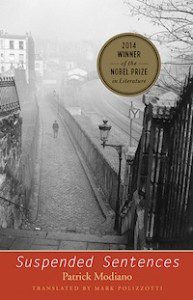
A few pages into “Afterimage,” the first novella in Patrick Modiano’s Suspended Sentences, a middle-aged photographer asks the nineteen year-old narrator what he plans to do with his future. “Write,” answers the young man. The photographer laughs. “Indeed,” the young man thinks, “writing is done with words, whereas he was after silence. A photograph can express silence. But words? That he would have found interesting: managing to create silence with words.” Whether or not Modiano wrote this line with a nod and a wink to the reader, the description of writing that creates “silence with words” best characterizes Suspended Sentences, a slim volume of three novellas that were originally published separately, but for this American edition were bundled together in a beautiful English translation by Mark Polizzotti.
The novellas that make up the trio—“Afterimage,” “Suspended Sentences,” and “Flowers of Ruin”—are permeated by a silence that creeps like fog among the various characters and their stilted interactions. It is a silence that confuses their thoughts, smothers their hopes, and lays bare their fears. In “Afterimage”, the young narrator imagines himself and a female companion waiting silently and indefinitely for the photographer to return to his apartment, such that “centuries from now, an archeologist would find the two of us mummified on the sofa.” “Suspended Sentences,” which tells the story of two brothers abandoned by their parents, reveals what happens when the brothers discover that the adults who serve as their de facto guardians have disappeared: “Nobody in the dining room or the kitchen. Or the living room […] It was as if no one had ever lived in those rooms […] The silence in the house was frightening.” And in “The Flower of Ruin,” a teenage boy who runs away from school but has no home to which he can return finds himself at the Paris Aquarium. Observing the fish, he sees that “they made no noise. They slid along the glass partitions. They opened their mouths without emitting a sound, but now and again bubbles would rise to the surface of the water. They would never call me to account.” The larger question of to what, exactly, the narrator would be called to account—not only in “The Flower of Ruin,” but in the two companion pieces as well—is a nebulous question that looms like a shadow over the entire book. To what does Modiano believe he must be called to account?
I mention Modiano, as well as his narrators, because according to Polizzotti, readers are often tempted to assume that Modiano’s fictions are “slices of autobiography.” That temptation is strong in Suspended Sentences, in which the three narrators—one for each novella—are all men with backgrounds, personal characteristics, and professional ambitions that are strikingly similar to Modiano’s. Two details in particular stand out. In all three novellas there is mention, if not an actual character, of a young brother who disappears or dies, as did Modiano’s when he was a child. There is also mention of a father figure, if not the actual father character, who, during the French Occupation, is arrested and held at the Drancy transit camp outside of Paris before an anticipated deportation to a concentration camp in the east, but who is released from Drancy with the help of an unknown, possibly criminal accomplice. Modiano’s father was a Jewish Italian businessman who experienced a similar imprisonment and release from Drancy.

Ultimately, however, the cumulative effect of Suspended Sentences is not the sense of reading slices of autobiography, but that of watching a gifted writer wrestle repeatedly with the same themes and characters. The experience of sameness is one that all three narrators share as well. An evening from thirty years ago replays itself as a dream night after night. The light in which a young man is photographed is the same light in which he walked with his mother years earlier. The hands of a clock are stuck forever at 5:30. “We only had to stay in the alley,” says the narrator of “The Flower of Ruin”, “and nothing would ever change.”
Reading Modiano is like watching a painter paint the same image again and again, and while the essential structure of each painting remains the same, the color, the emphasis, and the light change from canvas to canvas. Given the role that silence plays throughout the book, it is fitting that so much of the experience of reading Suspended Sentences is visual; the silent spaces Modiano writes into being create a visual dimension that shapes how he tells his stories. Suspended Sentences is not so much a set of novellas as it is a set of snapshots—yes, they are linked together, and they project a narrative of sorts, but that narrative is not fluid in the manner of a traditional novel or even a film.
Much has been written of Modiano’s exploration of the French Occupation and its effects, cultural and otherwise. In Suspended Sentences, the Occupation is a purgatorial force, trapping and preserving the characters in a moral and artistic limbo that does not dissipate with the conclusion of World War II. The Drancy transit camp serves as a metaphor for the experience of all who live within the Suspended Sentences universe; they are waiting, permanently, for release—through deportation, through rescue, or through escape. At the same time, the omnipresent threat of violence stalks every character. There is the mime who beats his wife; the trapeze artists who suffers a career-ending fall; the children who play in the garden where Dr. Guillotin lies buried; the couple that dies in an apparent murder-suicide.
“I feel a certain guilt,” says the narrator of “The Flower of Ruin”, “the reason for which remains vague: a crime to which I was an accomplice or witness, I couldn’t really say. And I hope this ambiguity will spare me from punishment […] But sooner or later, everyone is called to account.”
But to what does Modiano believe he must be called to account? The French Occupation? The death of a younger brother? Creating silence with words? These larger questions and answers remain ambiguous. But this ambiguity makes Suspended Sentences an exquisite joy to read.




